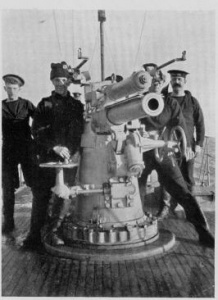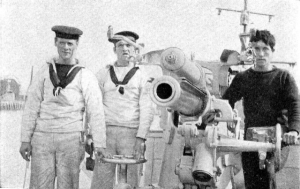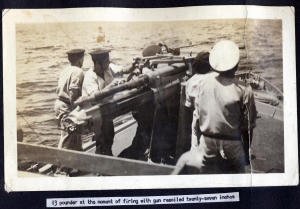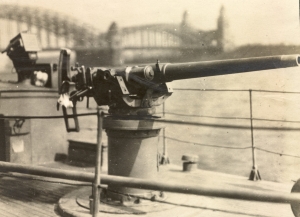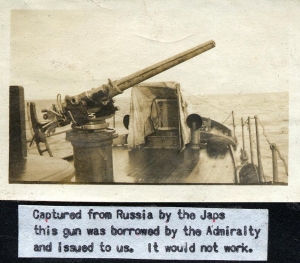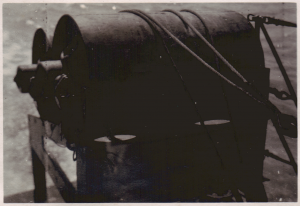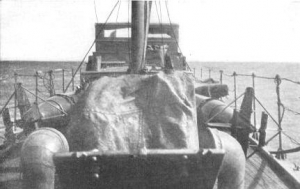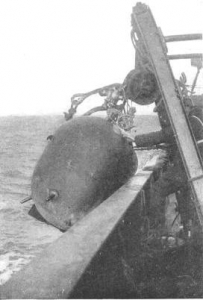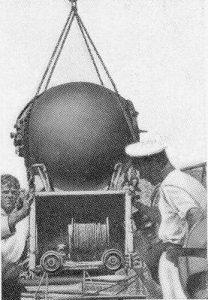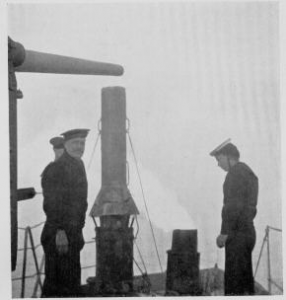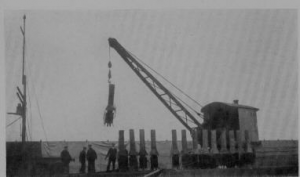Armament
The ML's were originally fitted with what Admiral Bacon (in The Dover Patrol) called "Old Horse Artillery 13-pounders" in a ship mounting on their foredeck. In The Auxilliary Patrol Chatterton mentions these as well. In his The Motor Launch Patrol, Maxwell gives us a story of training with the 13-pounders prior to assignment aboard his ML (314). Nutting, too, makes reference to the "wicked" 13-pounder (or 3-inch gun). Before long, Bacon says, these big guns were removed to arm merchant ships—leaving the ML's practically defenceless in fighting submarines (as opposed to listening for them, dropping depth charges, laying mines, etc.).
The ML's were originally fitted with what Admiral Bacon (in The Dover Patrol) called "Old Horse Artillery 13-pounders" in a ship mounting on their foredeck. In The Auxilliary Patrol Chatterton mentions these as well. In his The Motor Launch Patrol, Maxwell gives us a story of training with the 13-pounders prior to assignment aboard his ML (314). Nutting, too, makes reference to the "wicked" 13-pounder (or 3-inch gun). Before long, Bacon says, these big guns were removed to arm merchant ships—leaving the ML's practically defenceless in fighting submarines (as opposed to listening for them, dropping depth charges, laying mines, etc.).
All other accounts or references to guns aboard the ML's—typically references from later in the war—refer only to smaller guns. There are a few early photographs of the 13-pounders being manned by the ML crews. It seems likely that the majority of guns on the ML's were eventually 3-pounders. And many of these appear to have been second-hand, well-worn, and sometimes inoperable.
In addition to the foredeck gun, the typical ML also carried at least one Lewis gun, an assortment of small arms—rifles, pistols, etc.

The Lewis Gun |
Early on, the use of the 14-pound anti-submarine lance bomb was tried on the ML's. The lance bomb was essentially an explosive charge fixed to the end of a long pole. It was supposed to be used in much the same way that whalers threw harpoons before the harpoon gun was invented. One would stand at the bow, while the ML approached an enemy submarine and throw. I don't suppose anyone making such a throw (you'd think they would have to be awefully close to the submarine to even hit it) would actually survive the subsequent explosion unscathed—nevermind the probability of an ML actually sneaking up on a surfaced submarine. Eventually, the lance bomb fell into dis-use. (Thanks to Bill Swanson for some insight into the lance-bomb.)
Some ML's were fitted with a depth charge rack at the stern and, later in the war, many were fitted with permanent "sleepers" on the deck just aft of the bridge onto which removeable rails could be fitted for the setting of mines. And of course mine laying was only one of the tasks. Mine sweeping, an incredibly dangerous task usually associated with larger trawlers or dedicated minesweepers, turned out to be a task to which the ML's were well suited given their ability to quickly cover so much territory. Nutting states that:
"Frequently they swept in flottilas of four in quarter line formation using the "kite" to hold the sweeping cable extended. At other times the P.V sweep was used, consisting of a pair of paravanes towed off the quarters. These paravanes or "otters" were much the same as those with which all merchant and naval vessels traversing the war zone were equipped in order to protect them from moored mines. When used for sweeping, the paravanes operated in practically the same way except that they were towed off the quarters instead of off the forefoot, thereby offering no protection to the boat from which they were towed. Extending out at an angle of approximately 45 degrees, the towing cable of the paravane encountered the mooring wire of the mine, deflecting it out to the paravane where it was cut by the steel knives in the head of the latter. After being cut adrift the mine was exploded by gun fire."
The Cinderellas of the Fleet
A good overview of the genesis of minesweeping within the Royal Navy prior to the war, which places the participation of the ML's within a good context, can be found at the Barnett Research site. A nice set of scans of original documents by John Lambert detailing some British mines themselves is available on the Ship Modelling Mailing List site.
Finally, there were the smokescreen apparatus. These may not have been armaments in and of themselves but they were a critical tool of the ML's in carrying out one of their most important duties while on the Dover Patrol—screening the monitors and other craft during bombardments and of course the attacks on Zeebrugge and Ostend. This apparatus was mounted on the foredeck of the boat—the only relatively open space aboard. It appears that an ML would start laying smoke and make sternway into the wind or across the wind so as to avoid driving into her own smokescreen.
Invented by Wing Commander Frank Brock, RNAS, founder of the Royal Naval Experimental Station, the smokescreen apparatus was improved upon prior to the raids on Zeebrugge and Ostend to increase its effectivness. Lake describes the smokescreen:
Invented by Wing Commander Frank Brock, RNAS, founder of the Royal Naval Experimental Station, the smokescreen apparatus was improved upon prior to the raids on Zeebrugge and Ostend to increase its effectivness. Lake describes the smokescreen:
Brock's new and improved smokescreen, or "artificial fog" as he preferred to call it, was ingenious. Essentially, a chemical mixture was injected directly under pressure into the hot exhausts of the motor torpedo boats and other small craft or the hot interior surface of the funnels of destroyers. The larger ships [such as the M.L.'s - JLC] each had welded iron contraptions, in the region of ten feet in height, hastily assembled at Chatham. These were fed with solid cakes of phosphide of calcium. Dropped into a bucket-like container full of water, the resulting smoke and flames roared up a chimney and were dispersed by a windmill arrangement. It was more toxic than its predecessor. Taking in a lungul was an extremely unpleasant experience.
The Zeebrugge and Ostend Raids 1918
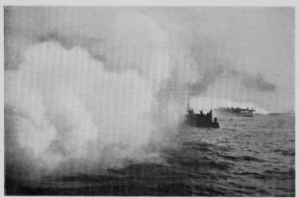
ML's laying smokescreen. |
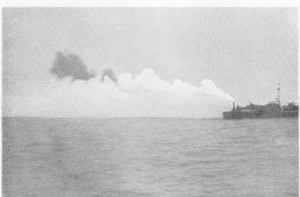
ML's laying smokescreen. |
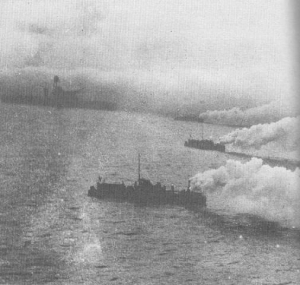
The monitor HMS Terror bombards the Belgian |
